The new type of hotel rescuing Italy’s hill villages
Ecco una sintesi dell’articolo di Liz Boulter apparso su The Guardian l’11 giugno 2016:
It was an unusual invasion: well-to-do people, most speaking strange tongues, and pulling their belongings behind them on little wheels. Arriving as couples, families, groups of friends, they spent money in the village shop and ate at its few restaurants. Feathers were occasionally ruffled when an outsider sat in some local’s chair at the bar but, overall, these “tourists” were seen as a good thing. This is not somewhere remote in the developing world, however, but Tuscany, just a few years ago. People often fail to grasp how much more there is to this region than Chiantishire and coach tours. Tuscany is bigger than Wales and almost as mountainous, with plenty of places where no one’s heard of Waitrose or – until recently – wheelie bags.
One of these villages, Semproniano, amid undulating woods and golden farmland in southern Tuscany, is Fulvio Ponzuoli’s childhood home, to which he returned in 2008 after a business career. He could see the potential of the 1,000-year-old village atop its wooded hill, and decided to develop it using a model dreamed up in Friuli, north-east Italy, in the 1980s as a way of reviving earthquake-ravaged communities. The model is the albergo diffuso, which translates best as “scattered hotel” and has really taken off this century. Rather than building a hotel to bring tourist euros into a picturesque village, or knocking buildings together, an albergo diffuso takes the more sustainable route of refurbishing empty or abandoned homes – generally within 150 metres of “reception” – as its guest rooms.
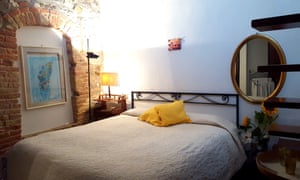
So at Fulvio’s Borgo di Sempronio (doubles from €85) reception is up the street from the bar, breakfast is in a former medieval storehouse round the corner, and rooms (with bathrooms and kitchens squeezed in corners and up steps) are in a dozen listed buildings, mostly built before 1400, dotted through the maze of alleys.
And though Fulvio and his partner, Roxana, are serious foodies – they grow a lot of their own food, plus ancient forms of wheat and pulses – they deliberately didn’t include a restaurant, preferring to see their guests bring custom to existing village businesses.
My husband and I had a two-bedroom suite up the hill, furnished with a mix of stylish new pieces and antiques – one bed was from an 18th-century brothel in Prato, though the mattress was new, Roxana assured me – and staying there offered a real village feel, particularly on warm evenings, when people sat on steps to chat and two small boys defeated baddies up and down “our” street.
If we’d been able to tear ourselves away, Grosseto, Lake Bolsena and the Maremma coast are within an hour or two’s drive, the Saturnia hot springs and ski slopes of Monte Amiata nearer. But we preferred ice-creams at local hub Bar Tubino, reading in the square at the top of the village, and a 10-minute pootle to the tiny Knights Templar village of Rocchette di Fazio – even prettier than Semproniano, it is now home to just 10 permanent residents.
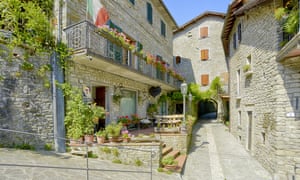
At the other end of Tuscany, over a high Apennine pass, Ercole Lega has been running restaurant Locanda Senio in the village of Pallazzuolo, by the Senio river, for over 30 years. His wife, Roberta, works slow-food miracles in the kitchen and they have gradually been adding cosy period-feeling en suite rooms in narrow streets (doubles from €105 B&B). Alpine-feeling Pallazzuolo is very different from Semproniano, with red and green shutters on sturdy stone houses and steep wooded hills all around. There’s wonderful walking nearby, in mountains reaching to 1,187 metres, and, for urban buzz, trains run from nearby Marradi station to Florence (€12 return, about an hour), Bologna or Faenza.
Ercole is passionate about alberghi diffusi. “It’s the most genuine type of tourism,” he said. “It can’t be faked, packaged or taken over by a multinational. Visitors live cheek by jowl with the people of the village, eating food and wine produced here, or next door.”
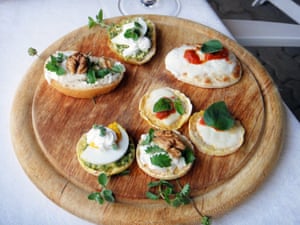
And the food and wine are excellent: at dinner (on the terrace by the chlorine-free pool), Ercole was full of information about the history or provenance of each of the five courses he brought out to us. Standouts were radicchio and almond crostini, smoked salmon with tiny grapes the size of redcurrants, gnocchi stuffed with ricotta, and Roberta’s homemade breads.
Italy’s regional governments are gradually setting up legal norms for alberghi diffusi, simplifying the licences hugely. To Roxana and Ercole’s irritation, Tuscany is still wrangling over details, but Puglia, in the south, enacted legislation in 2012, and several of the region’s white stone villages have taken the idea and run with it.
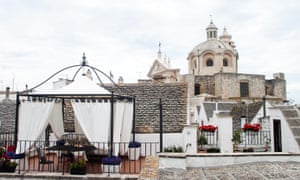
The albergo diffuso is perfectly suited to Italy, where almost every hill is topped with an ancient settlement, most beautifully atmospheric and tragically depopulated. It’s also perfectly suited to travellers wanting a sense of place and contact with locals, not other tourists.
MORE ALBERGHI DIFFUSI
Border hideaway, Piedmont
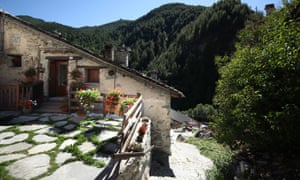
High in the Piedmont Alps, near the French border, Locanda degli Elfi is a great base for ski touring or snowshoeing. Its six rooms, one suite and one apartment are in renovated stone houses in Borgata Preit hamlet.
• Doubles from €90 B&B, locandaelfi.it
Rimini refuge, Emilia-Romagna
Verucchio sits on a rocky spur dominating the plains of eastern Emilia-Romagna. Le Case Antiche has rooms in four houses in its historic centre. Your fridge is stocked each day with generous breakfast supplies, including fruit and cake. Adriatic beaches are a short drive away.
• Doubles from €85, lecaseantiche.it
Assisi agriturismo, Umbria
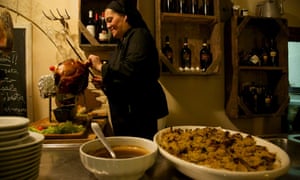
Combine an albergo diffuso with Italy’s other holiday invention, the agriturismo, at Malvarina in Assisi. It has cottages and rooms in old buildings, does regional dinner each night, and offers wine tours and cooking courses. In January, guests can attend a maialata – killing of the pig – and see it made into sausages, pancetta and more before a huge feast.
• Doubles from €80, malvarina.it
Sleeping beauty awakened, Umbria
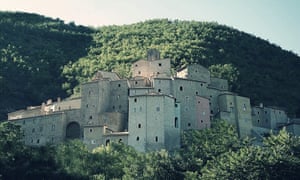
Seaside stay, Molise
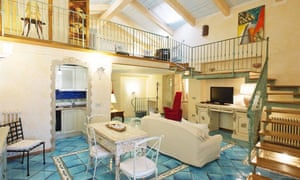
In the little-visited Molise region, north of Puglia, Residenza Sveva has single, double and family rooms in former fishermen’s homes in the seaside village of Termoli. Reception and breakfast are in a period building by the 12th-century church, and there are beaches within walking distance to north and south.
• Doubles from €80, residenzasveva.com
Pagan pleasures, Sicily
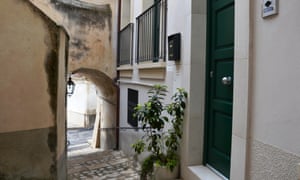
Near the baroque cities of Ragusa and Modica, Unesco-listed Scicli is on the site of a pagan temple. Rooms and apartments in its albergo diffuso are in elegant limestone palazzos around the town, with marble bathrooms, frescoed ceilings and balconies overlooking winding alleys and the golden facades of churches. The floors are covered in ancient Renaissance majolicas, decorated (tin-glazed floor tiles) and some suites have an internal, Arabic-style lemon orchard. Breakfast at the Millennium cafe is an indulgent affair, with Sicilian pastries such as ricotta-stuffed cannoli. Reception and a bookshop are within the cafe.
• Doubles from €90, sciclialbergodiffuso.it
Renaissance palace, Lazio
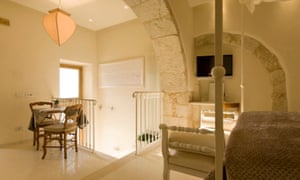
This Renaissance palace of Sotto Le Stelle, in Picinisco, once hosted monks, bishops and pilgrims heading for the Madonna of Canneto sanctuary. Reception is under an ancient arch in front of a frescoed Madonna, and each room overlooks a landscape dotted with monasteries and churches. Breakfast is served by village women, who bring fresh bread topped with ricotta and acacia honey to your room. The concierge will organise activities from bear watching in Abruzzo’s national park to bike riding across Comino valley, visiting nearby towns of Atina and Settefrati.
• sottolestellepicinisco.it, doubles from €95 B&B
Find details of other alberghi diffusi at alberghidiffusi.it
Articolo originale qui: http://www.theguardian.com/travel/2016/jun/11/italy-alberghi-diffusi-village-hotels
 INTERNATIONAL PRESS
INTERNATIONAL PRESS